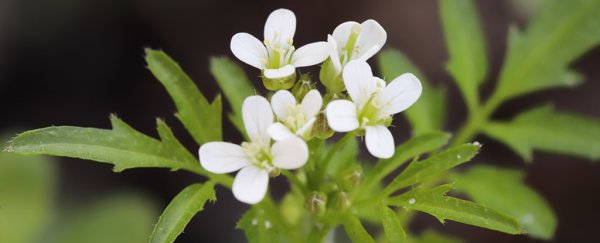Researchers have just discovered a previously unknown process that makes sense of the 'secret decisions' plants make when releasing carbon back into the atmosphere.
"We found that plants control their respiration in a way we did not expect, they control how much of the carbon from photosynthesis they keep to build biomass by using a metabolic channel," University of Western Australia plant biochemist Harvey Millar told ScienceAlert.
"This happens right as the step before they decide to burn a compound called pyruvate to make and release CO2 back to the atmosphere."
If you think back to high-school biology, you might remember that during photosynthesis, plants make sugar or sucrose. The plant typically makes an excess of sucrose; some is stored, some is degraded. This is called the citric acid (or tricarboxylic acid) cycle, and it's equally important for life.
As part of this cycle, sucrose, which has twelve carbon atoms, is broken down into glucose with six carbons. Then glucose is broken into pyruvate, which has three carbons. Using pyruvate for energy produces carbon as a waste product, so it's at this point where the 'decision' is made in the plant.
"Pyruvate is the last point for a decision," Millar told ScienceAlert.
"You can burn it and release CO2, or you can use it to build phospholipids, stored plant oils, amino acids and other things you need to make biomass."
The discovery came about while working on a classic plant model organism called thale cress (Arabidopsis thaliana). The researchers, led by University of Western Australia plant molecular scientist Xuyen Le, labeled pyruvate with C13 (a carbon isotope) to track where it was being shifted during the citric acid cycle, and found that pyruvate from different sources was being used differently.
This means the plant can actually track the source of the pyruvate and act accordingly, choosing to either release it, or hold on to it for other purposes.
"We found that a transporter on mitochondria directs pyruvate to respiration to release CO2, but pyruvate made in other ways is kept by plant cells to build biomass – if the transporter is blocked, plants then use pyruvate from other pathways for respiration," Le said.
"Imported pyruvate was the preferred source for citrate production."
This ability to make decisions, the team suggests, breaks the normal rules of biochemistry, where typically, every reaction is a competition and the processes don't control where the product goes.
"Metabolic channeling breaks these rules by revealing reactions that don't behave like this, but are set decisions in metabolic processes that are shielded from other reactions," says Millar.
"This is not the first metabolic channel to ever be found, but they are relatively rare, and this is the first evidence of one governing this process in respiration."
Although plants are wonderful stores of CO2 – forests alone store around 400 gigatonnes of carbon – not every molecule of CO2 that is taken up by plants is then kept. Around half of the carbon dioxide that plants take up is released back into the atmosphere.
Being able to get plants to store a little more carbon dioxide in this process could be a fascinating way to help our climate change woes.
"As we consider building and breeding plants for the future – we shouldn't just be thinking about how they can be good food and food for our health, but also if they can be good carbon storers for the health of the atmosphere that we all depend on," Millar told ScienceAlert.
Such futureproofing is yet to come, as the researchers have only just discovered this biochemical process to behind with. But if we can hijack the way plants make decisions about carbon storage, it could be one piece of the bigger climate change mitigation puzzle.
The research has been published in Nature Plants.
